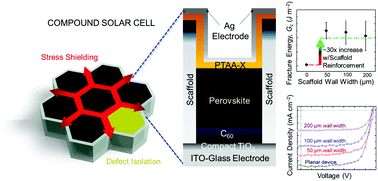当前位置:
X-MOL 学术
›
Energy Environ. Sci.
›
论文详情
Our official English website, www.x-mol.net, welcomes your
feedback! (Note: you will need to create a separate account there.)
Scaffold-reinforced perovskite compound solar cells†
Energy & Environmental Science ( IF 32.4 ) Pub Date : 2017-08-23 00:00:00 , DOI: 10.1039/c7ee02185b Brian L. Watson 1, 2, 3, 4 , Nicholas Rolston 1, 2, 3, 4 , Adam D. Printz 1, 2, 3, 4 , Reinhold H. Dauskardt 1, 2, 3, 4
Energy & Environmental Science ( IF 32.4 ) Pub Date : 2017-08-23 00:00:00 , DOI: 10.1039/c7ee02185b Brian L. Watson 1, 2, 3, 4 , Nicholas Rolston 1, 2, 3, 4 , Adam D. Printz 1, 2, 3, 4 , Reinhold H. Dauskardt 1, 2, 3, 4
Affiliation

|
The relative insensitivity of the optoelectronic properties of organometal trihalide perovskites to crystallographic defects and impurities has enabled fabrication of highly-efficient perovskite solar cells by scalable solution-state deposition techniques well suited to low-cost manufacturing. Fracture analyses of state-of-the-art devices, however, have revealed that both the perovskite active layer and adjacent carrier selective contacts are mechanically fragile—a major obstacle to technological maturity that stands to significantly compromise their thermomechanical reliability and operational lifetimes. We report a new concept in solar cell design, the compound solar cell (CSC), which addresses the intrinsic fragility of these materials with mechanically reinforcing internal scaffolds. The internal scaffold effectively partitions a conventional monolithic planar solar cell into an array of dimensionally scalable and mechanically shielded individual perovskite cells that are laterally encapsulated by the surrounding scaffold and connected in parallel via the front and back electrodes. The CSCs exhibited a significantly increased fracture energy of ∼13 J m−2—a 30-fold increase over previously reported planar perovskite (∼0.4 J m−2)—while maintaining efficiencies comparable to planar devices. Notably, the efficiency of the microcells formed within the scaffold is comparable to planar devices on an area-adjusted basis. This development is a significant step in demonstrating robust perovskite solar cells to achieve increased reliability and service lifetimes comparable to c-Si, CIGS, and CdTe solar cells.
中文翻译:

脚手架增强钙钛矿型复合太阳能电池†
有机金属三卤化物钙钛矿的光电特性对晶体缺陷和杂质的相对不敏感性使得能够通过非常适合于低成本制造的可扩展溶液状态沉积技术来制造高效钙钛矿太阳能电池。然而,对现有技术设备的断裂分析表明,钙钛矿活性层和相邻的载流子选择触点在机械上都是易碎的,这是技术成熟的主要障碍,严重阻碍了其热机械可靠性和使用寿命。我们报告了太阳能电池设计中的一个新概念,即复合太阳能电池(CSC),它可以通过机械加固内部支架来解决这些材料的固有脆性。通过前后电极。CSC的断裂能显着增加,约为13 J m -2,是以前报道的平面钙钛矿(〜0.4 J m -2)的30倍,同时保持了与平面装置相当的效率。值得注意的是,在面积调整的基础上,形成在支架内的微电池的效率与平面装置相当。这一发展是展示强大的钙钛矿太阳能电池以实现与c-Si,CIGS和CdTe太阳能电池相比可提高的可靠性和使用寿命的重要一步。
更新日期:2017-08-23
中文翻译:

脚手架增强钙钛矿型复合太阳能电池†
有机金属三卤化物钙钛矿的光电特性对晶体缺陷和杂质的相对不敏感性使得能够通过非常适合于低成本制造的可扩展溶液状态沉积技术来制造高效钙钛矿太阳能电池。然而,对现有技术设备的断裂分析表明,钙钛矿活性层和相邻的载流子选择触点在机械上都是易碎的,这是技术成熟的主要障碍,严重阻碍了其热机械可靠性和使用寿命。我们报告了太阳能电池设计中的一个新概念,即复合太阳能电池(CSC),它可以通过机械加固内部支架来解决这些材料的固有脆性。通过前后电极。CSC的断裂能显着增加,约为13 J m -2,是以前报道的平面钙钛矿(〜0.4 J m -2)的30倍,同时保持了与平面装置相当的效率。值得注意的是,在面积调整的基础上,形成在支架内的微电池的效率与平面装置相当。这一发展是展示强大的钙钛矿太阳能电池以实现与c-Si,CIGS和CdTe太阳能电池相比可提高的可靠性和使用寿命的重要一步。











































 京公网安备 11010802027423号
京公网安备 11010802027423号